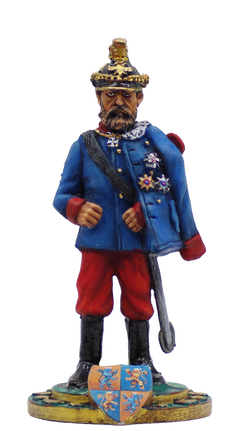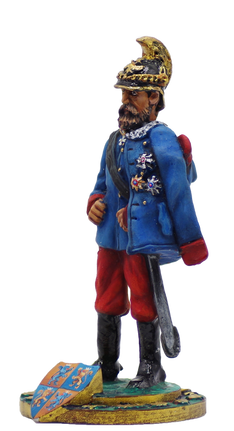
Arnošt Karel
Count of Waldstein-Wartenberg
Ernst Karl Graf von Waldstein-Wartenberg (4. February 1849 Prague - 27. June or 28. Brioni (born June 1913) was a Czech nobleman of the Waldstein-Wartenberg family, politician and owner of the Mnichovo Hradište estate. He was the first son of Arnoš František of Waldstein-Wartenberg (1821-1904) and his first wife Anna Marie of Schwarzenberg (1830-1849). Mother came from the orlicke branch of the Schwarzenbergs, she was the younger sister of Prince Charles III. from Schwarzenberg (1824-1904) and died a week after giving birth. Arnost's half-brother from his father's second marriage and heir was Adolf Arnost of Waldstein-Wartenberg (1868-1930). He fell in love with his stepsister's governess. At the age of seventeen, he joined the Army, first to the Dragoons, later to the hussars. In 1866, together with his father, he participated in the Prussian-Austrian war. He was slightly wounded in the Battle of Hradec Králové. He left the army two years later. Among his hobbies was music, he admired the work of the German composer Richard Wagner. In 1869-1872, he made a long journey through the Orient and Egypt, where the Suez Canal was opened in 1869. He brought some souvenirs from his travels. He was also interested in history and art. He was friends with historians Tomáš Václav Bílek and Hermann Halwich. He held several honorary offices. In 1878 he was

appointed C. k. in 1904, the Privy Council. After the death of his father, he became the highest hereditary slicer of the Czech Kingdom and a hereditary member of the Austrian House of Lords. He was also a member of the Czech diet (1880-1883, 1901). He inherited from his father in 1904 the majoritarian trust of Mnichovo Hradište, Belá pod Bezdezem, Doksy, Nový Berštejn, Štáhlavy, Chocenice and the Waldstein Palace in Prague, which was established by his grandfather Kristián of Waldstein-Wartenberg in 1858. He had three wives. On 18. in May 1873 he married in Prague Frantiska of Thun-Hohenstein (3.8.1852 Žehušice – 24.7.1894 Karlovy Vary), daughter of Joseph Oswald I. count of Thun-Hohenstein (1817-1883) and Johana of Salm-Reifferscheidt-Hainspach (1827-1892). In 1878 she was made a dame of the order of the star cross. Arnost's younger half-sister Kristiana (1859-1935) married Josef's brother Osvald II. from Thun-Hohenstein (1849-1913), owner of Klášterec nad Ohrí. Thus, there was a double connection between families. The newlyweds lived at Kozel Castle. In this first marriage, three children were born. The first-born son lived one year, the third child died the day after birth. Only one daughter survived into adulthood. The first wife died of cancer at the age of 41. The second time Arnost married 7. November 1898 in Vienna with Josefina of Rumerskirch (4.9.1848-28.11.1901 Prague), daughter of Gottfried count of Rumerskirch and Luisa Goldstein. He eventually married 1. February 1904 in Prague with Maria of Rumerskirch (31.1.1852 Olomouc – 30.12.1955 Prague), who was the sister of his second wife and held the honorary office of Palace lady.

Imperial and Royal Dragoon Regiment "Kaiser Franz I." No. 1. The unit was set up as the "Second Carabinier Regiment Althan" in the Austrian-Habsburg Army and existed as the Dragoon Regiment "Kaiser Franz I." No. 1 in the Imperial and Royal or Joint Army within the Austro-Hungarian Land Forces until the end of the First World War. Until 1798, the regiments were named after their respective regiment owners (who did not have to be the commander). There was no binding spelling rule. (e.g. Regiment Graf Serbelloni - or Regiment Serbelloni.) With each change of owner, the regiment in question also changed its name. After the system was changed in 1798, the numbered designation was the primary choice, which could be linked to the owner's name under certain circumstances. The regiment was renamed Cuirassier Regiment No. 1. The last name used was assigned to the regiment for perpetuity. In 1778 the regiment was with the army in Bohemia. The Chevauxlegers Division fought at Arnau. 1779 The Chevauxlegers Division fought at Wartha. 1793 Battles on the Upper Rhine. Parts of the regiment fought in battles before Landau. Capture of the Weissenburg Lines. The Chevauxlegers
Division was meanwhile seconded to the Netherlands and fought in the capture of Huy, at Tirlemont, Neerwinden, Saultain, Menin and Orchies. 1794 A detachment was involved in the Battle of Kaiserslautern, the Chevauxlegers Division fought before Landrecies and at Tournai. 1795 Battles before the fortress of Mainz, a division fought a battle near Trippstadt. 1796 Battle of Würzburg, the Chevauxlegers Division was deployed in the battles near Kuppenheim and Neuburg. 1797 Only the Chevauxlegers division in a battle near Frankfurt am Main. 1799 Battles in front of Mannheim, parts of the regiment in the battle at Knittlingen and Wiesloch. 1800 After the Battle of Biberach, retreat battles at Eichen and Gutenzell. Battle of Hohenlinden, rearguard battle near Salzburg. 1805 Three divisions took part in the Battle of Austerlitz, retreat battles with the 3rd Division covering the imperial court camp. 1809 Assigned to the II Reserve Corps. Battle of Eggmühl, Battle of Aspern, Battle of Wagram and Battle of Znaim. 1813 First two divisions in the Battle of Dresden, then the whole regiment in the battle at Liebertwolkwitz and the Battle of the Nations near Leipzig. 1814 Battles at Troyes, la Ferté and Fére-Champenoise. 1815 Patrol and security duties without combat activity in France. 1848 A squadron was deployed to suppress the unrest in Prague. The Lieutenant Colonel Division fought under Field Marshal Windisch-Graetz and took part in the capture of Vienna. In 1849, until the start of the summer campaign, the unit was stationed in Vienna, then fought in Hungary against the troops of the secessionist government at Szered, Pered (Tešedíkovo), in both battles at Komorn, then at Szőreg and Temesvár. Of the other two divisions remaining in Bohemia, one was sent to the siege of Komorn in September. 1866 Four squadrons fought with the Northern Army in the Battle of Königgrätz. Parts of the regiment fought a battle at Tischnowitz.

The House of Waldstein or House of Valdštejn is a Bohemian noble family that originated from the Kingdom of Bohemia as a branch of the Markwartinger family (House of Markvartic) and gained prominence during the reign of the Premyslid dynasty. The house was founded by Jaroslav of Hruštice (1234–1269) and named after Valdštejn Castle near Turnov in northern Bohemia. The family's most prominent members include Albrecht von Wallenstein, the Imperial general during the Thirty Years' War, and Ferdinand Ernst von Waldstein, a statesman and early patron of Ludwig van Beethoven. The Waldstein noble family originated from the medieval Markvartici clan, which gained influence at the Premyslid court in Prague under King Ottokar II of Bohemia. From about 1260, Burgrave Jaroslav of Hruštice (1234–1269) had Waldštejn Castle erected. His son Zdenek was the first documented "Lord of Waldštejn"; allegedly he accompanied King Ottokar II on his Prussian crusade. Upon his death, his possessions were divided among his numerous descendants. The Waldsteins again appeared in public life from the 15th century onwards. Formerly a poor and less significant family, they gradually acquired large properties in the territory of the Crown of Bohemia (especially in Bohemia and Moravia), received
prominent positions and – since the 17th century onward – produced many statesmen and civil servants. Albrecht von Wallenstein himself came from a modest cadet branch which since 1548 held the small estate of Hermanice. After the 1620 Battle of White Mountain, he purchased several confiscated lordships of his Protestant relatives. In 1628, he was one of the first among the Bohemian nobility to be promoted to Graf (count) status, then to Reichsgraf (imperial count) two years later. After uniting with the extinct line of another Bohemian noble family, the Lords of Vartenberk (German: Wartenberg), the present family title since 1758 is "Count of Waldstein, Lord of Wartenberg".
Awards: Insignia, sash and star of the Sovereign Military Order of Malta, Stars of the Imperial Order of Saint Prince Vladimir and Royal Guelphic Order (Königlicher Guelphen-Orden).






